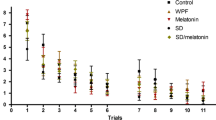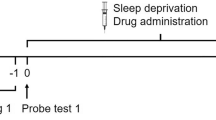Abstract
Objectives are to examine the effects of sleep deprivation (SD) on spatial learning and memory in mice, to determine how SD effects the expression of phosphorylated cyclic AMP responsive element binding protein (pCREB) in mouse hippocampus, and to explore the mechanism of influence of sleep deprivation on cognitive function. Twenty, 3-month-old female C57BL/6J mice were randomly assigned into two groups, the sleep deprivation group (SD, n = 10) and control group with normal sleep (CC, n = 10). The mice in SD group were deprived sleep by “gentle touch” for 20 days and then all the mice were subjected for Morris Water Maze test to determine the mean latency of escape (LE). Percentage of time spent in the target quadrant was calculated. Mouse hippocampus pCREB levels were quantified by western blot. Compared with CC group, SD mice had a significantly longer mean LE time (P < 0.05) and spent less time in the target quadrant (P < 0.05). Western blot revealed that hippocampus pCREB levels in the SD group were significantly lower than that in control group (0.71 ± 0.03 vs 0.82 ± 0.06, P < 0.01). The impairment in spatial learning and memory in sleep-deprived animals may be associated with the reduction of pCREB in the hippocampus.

Similar content being viewed by others
References
Yang, R. H., Hu, S. J., Wang, Y., Zhang, W. B., Luo, W. J., & Chen, J. Y. (2008). Paradoxical sleep deprivation impairs spatial learning and affects membrane excitability and mitochondrial protein in the hippocampus. Brain Research, 1230, 224–232.
Li, W. E., & Nagy, J. I. (2000). Activation of fibres in rat sciatic nerve alters phosphorylation state of connexin-43 at astrocytic gap junctions in spinal cord: Evidence for junction regulation by neuronal-glial interactions. Neuroscience, 97, 113–123.
Frank, M. G., Morrissette, R., & Heller, H. C. (1998). Effects of sleep deprivation in neonatal rats. American Journal of Physiology, 275, R148–R157.
Morris, R. G., Garrud, P., Rawlins, J. N., & O’Keefe, J. (1982). Place navigation impaired in rats with hippocampal lesions. Nature, 297, 681–683.
Zisapel, N. (2007). Sleep and sleep disturbances: Biological basis and clinical implications. Cellular and Molecular Life Sciences, 64, 1174–1186.
Dang-Vu, T. T., Desseilles, M., Peigneux, P., & Maquet, P. (2006). A role for sleep in brain plasticity. Pediatric Rehabilitation, 9, 98–118.
Jaeger, L. B., Farr, S. A., Banks, W. A., & Morley, J. E. (2002). Effects of orexin-A on memory processing. Peptides, 23, 1683–1688.
Bruel-Jungerman, E., Davis, S., & Laroche, S. (2007). Brain plasticity mechanisms and memory: A party of four. Neuroscientist, 13, 492–505.
Casu, M. A., Pisu, C., Sanna, A., Tambaro, S., Spada, G. P., Mongeau, R., et al. (2005). Effect of delta9-tetrahydrocannabinol on phosphorylated CREB in rat cerebellum: An immunohistochemical study. Brain Research, 1048, 41–47.
Hara, T., Hamada, J., Yano, S., Morioka, M., Kai, Y., & Ushio, Y. (2003). CREB is required for acquisition of ischemic tolerance in gerbil hippocampal CA1 region. Journal of Neurochemistry, 86, 805–814.
Porte, Y., Buhot, M. C., & Mons, N. (2008). Alteration of CREB phosphorylation and spatial memory deficits in aged 129T2/Sv mice. Neurobiology of Aging, 29, 1533–1546.
Monti, B., Berteotti, C., & Contestabile, A. (2005). Dysregulation of memory-related proteins in the hippocampus of aged rats and their relation with cognitive impairment. Hippocampus, 15, 1041–1049.
Bourtchuladze, R., Frenguelli, B., Blendy, J., Cioffi, D., Schutz, G., & Silva, A. J. (1994). Deficient long-term memory in mice with a targeted mutation of the cAMP-responsive element-binding protein. Cell, 79, 59–68.
Han, J. H., Kushner, S. A., Yiu, A. P., Cole, C. J., Matynia, A., Brown, R. A., et al. (2007). Neuronal competition and selection during memory formation. Science, 316, 457–460.
Acknowledgments
This study is supported by natural Science Foundation Project of CQ CSTC (2008BB5014) and Scientific Research & Innovation Fund of the Third Military Medical University of China (2007XG063).
Author information
Authors and Affiliations
Corresponding author
Rights and permissions
About this article
Cite this article
Xu, ZQ., Gao, CY., Fang, CQ. et al. The Mechanism and Characterization of Learning and Memory Impairment in Sleep-Deprived Mice. Cell Biochem Biophys 58, 137–140 (2010). https://doi.org/10.1007/s12013-010-9098-8
Published:
Issue Date:
DOI: https://doi.org/10.1007/s12013-010-9098-8




